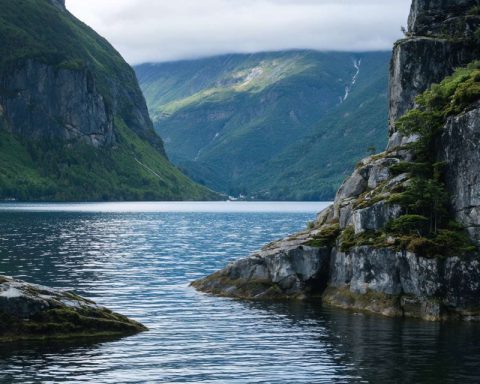- Cenotes in Mexico’s Yucatán Peninsula offer a surreal adventure, attracting thrill-seekers and nature lovers.
- These underwater caves are crystal-clear and filled with geological wonders, including stalactites and labyrinthine tunnels.
- Cenotes hold cultural significance, revered by the ancient Maya as sacred gateways to the underworld.
- Divers encounter unique ecosystems, such as blind fish, adapted to the caves’ darkness.
- There’s a call to conserve these fragile environments as awareness of their ecological importance rises.
- The experience is not only about adrenaline but also about understanding and respecting the mystical, historical, and natural aspects of these caves.
An enigmatic journey beneath the earth’s surface awaits those who dare to plunge into the surreal world of Mexico’s underwater caves. These submerged wonders, known as cenotes, offer a breathtaking adventure for thrill-seekers and nature lovers alike. Nestled in the Yucatán Peninsula, these natural sinkholes hold secrets of geological and cultural history, inviting explorers to uncover their mystique.
Wrapped in the emerald cloak of the jungle, cenotes glisten like jewels amid the dense foliage. Crystal-clear waters beckon divers with their azure allure, promising an experience steeped in both serenity and awe. Imagine slipping beneath the shimmering surface, where shafts of sunlight dance across limestone walls adorned with stalactites, their forms shaped over millennia.
Equipped with diving gear and a sense of wonder, adventurers navigate through labyrinthine tunnels, where the silence is profound and every movement seems to echo eternity. Tilting your headlamp, you catch a glimpse of blind fish darting through the shadows, testament to a secluded ecosystem adapted to complete darkness. The water is pure, devoid of pollutants, offering uninterrupted visibility over a hidden world.
Beyond their natural beauty, cenotes are steeped in mystery and cultural significance. The ancient Maya revered them as sacred gateways to the underworld, places of both life and death. Visiting these sites, divers often feel a profound connection to the past, a link to the ancient civilizations that once thrived here. Bones and artifacts have been discovered alongside these subterranean paths, silently narrating tales of rituals and offerings to gods long forgotten.
Yet, this unforgettable dive is not solely an adrenaline-filled escapade but a call to stewardship of these fragile environments. As awareness of their ecological significance grows, so does the responsibility of visitors to preserve these natural wonders for future generations.
The takeaway? Within these mystical underwater caves, adventure lies waiting for those ready to embrace the unknown. But as we explore, we must tread lightly, balancing our thirst for discovery with a commitment to conservation. In this underwater ballet of light and shadow, we find not just adventure, but a humbling reminder of our place in a world wondrously larger than ourselves.
Discover the Depths: Mysteries and Magic of Mexico’s Underwater Caves
Mexico’s cenotes are more than just geological marvels; they represent a fascinating confluence of history, nature, and adventure. While the original article captures the allure of these submerged caves, there is much more to uncover about the cenotes beyond just their stunning beauty and historical significance.
How to Dive into the Cenotes Safely
1. Research and Choose Wisely: With over 6,000 cenotes in the Yucatán Peninsula, picking the right one for your skill level is crucial. Popular sites include Dos Ojos, Gran Cenote, and Ik Kil.
2. Hire a Certified Guide: Diving in cenotes can be complex, with tight passages and unique conditions. A professional guide ensures not just safety, but also enhances the experience with insights into the site’s history and ecosystem.
3. Equipment Check: Ensure your diving gear is suitable for cavern diving. Use lights, navigate using lines, and stick to a group or guide to avoid getting lost.
4. Respect the Environment: Avoid touching formations or artifacts and do not disrupt the aquatic life. Many cenotes are protected areas, so adhere to all rules and guidelines.
Real-World Use Cases
Beyond recreational diving, cenotes are crucial for scientific research. Geologists study stalactites and stalagmites to understand past climate conditions. Biologists explore these ecosystems for rare species, like the blind fish and unique microorganisms that offer insight into evolutionary adaptations.
Market Forecasts & Industry Trends
Eco-tourism, including cenote diving, is on the rise. Travelers seek authentic, sustainable experiences, which has led to the increased popularity of cenote tours. This eco-awareness promotes conservation efforts, leading to partnerships between tour operators and environmental organizations.
Cenote Features and Specifications
– Formation: Cenotes are formed by the collapse of limestone bedrock, revealing the groundwater below.
– Depths: While some are shallow, others plunge over 100 meters.
– Visibility: The crystal-clear water allows for excellent visibility, making them popular among divers.
Security & Sustainability
The sustainability of cenote tourism is key to preserving these natural wonders. Efforts are in place to regulate the number of visitors and enhance educational outreach about ecological impacts. Improved infrastructure, such as access paths and visitor limits, helps minimize human disturbance.
Pressing Questions
– Why are cenotes important? Cenotes are vital as they provide a unique habitat for numerous species and are a significant freshwater resource for the region.
– Are there cultural restrictions? Many cenotes hold sacred value for indigenous communities. Understanding and respecting these cultural elements is integral to any visit.
Actionable Recommendations
1. Visit Responsibly: Choose operations that prioritize sustainability and respect for local cultures.
2. Educate Yourself: Learn about the ecological and cultural significance of cenotes before you dive.
3. Support Conservation: Consider donating to or volunteering with organizations dedicated to preserving the Yucatán’s natural heritage.
For more information on exploring Mexico and its natural wonders, visit the official tourism site at Visit Mexico.
In conclusion, while cenote diving offers unparalleled adventure, it also invites participants to partake in a deeper commitment to preservation efforts. Embrace the unknown with a sense of responsibility and awe, knowing that every dive is a step towards understanding and conserving these enchanting realms beneath the surface.




















